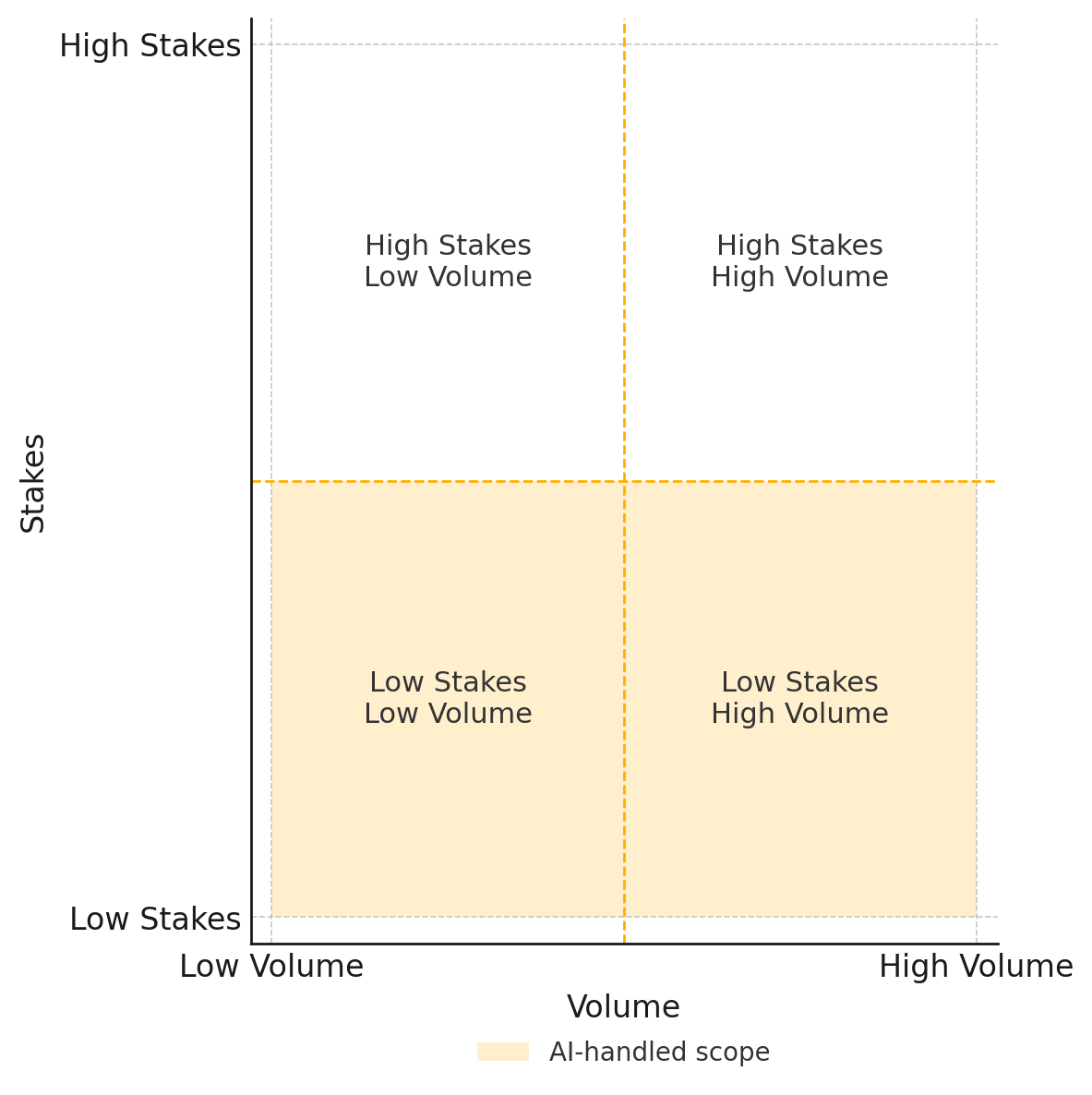Beat the Bot: The Four Quadrants of AI‑Enabled Work
How to Use AI before AI Uses You
The essence of strategy is choosing what not to do.
—Michael Porter
For every minute spent in organizing, an hour is earned.
—Benjamin Franklin
Instead of AI killing 30% of the jobs, which would be catastrophic, AI is killing 30% of your job—and that’s an amazing time‑saver.
—Vitalik Buterin
Above: Man and machine > man versus machine.
Sometimes I envy the ostrich.
When panic looms or it all gets to be a bit too much, the big bird simply buries its head and waits for the danger to pass.1
We humans enjoy no such luxury, especially not in 2025 when AI can knock out a rough draft faster than we can type a single word.
Ignoring AI is the modern equivalent of refusing to learn email in the 90s: it feels righteous until you’re packing your work possessions into a cardboard box.
My friend Ben Saltiel sounded the alarm in a recent analysis:
Longtime readers might remember this dude (pun very much intended) from our collaboration explaining LLMs:
Using The Big Lebowski to Understand Artificial Intelligence
AI does not start and stop at your convenience. —Walter Sobchak (probably)
I’ve said it once, and I’ll say it again: Ben’s writing offers a blend of deep insight, biting sarcasm, and dry humor. He is an analyst’s analyst whose work is mutually exclusive, collectively exhaustive, sober, and statistically significant.
His introduction begins with a bold claim:
[I]f you are not already using LLMs on a daily basis in 2025, you are slowly making yourself unemployable and less productive. Start using LLMs or your professional life will suffer.
This is not hyperbole. He continues:
LLM adoption is much more widespread than you think.
In February 2025, ChatGPT had over 400 million weekly active users (WAUs), this jumped to 800 million by April. I could not find any evidence that another product has ever managed a similar feat that quickly. As a frame of reference, companies such as X/Twitter, Spotify and Snapchat have between 500 - 750 million monthly active users (MAUs). For most apps a strong ratio between WAUs to MAUs is generally between 20-25% (4:1 or 5:1), but for high engagement platforms like WhatsApp, Instagram, Youtube etc. this can range from 50-70%. Therefore it’s likely that ChatGPT’s monthly active user number is starting to approach Web2.0 consumer tech giants such as Youtube (2.5 billion MAUs), Instagram (2.4 billion) and TikTok (1.69 billion)…
Speaking of the internet, it took almost a decade for nearly half of American adults to get online while relying on broadband and needing to download AOL or some other software to access it. In only about 2.5 years, ChatGPT and LLMs have already achieved a similar penetration rate with much smaller hurdles for continued adoption. Even beyond the consumer web, seemingly every company needs to come up with a response to the question “What is your AI strategy?”. The fine folks at McKinsey report 78% of organizations claim to be using AI in at least one business function, up from 72% in 2024 and 55% in 2023.
Behind the headline is a quieter revolution: white collar work is stuffed with tasks that are both low stakes and high volume. Those are the first dominoes to fall, the low-hanging fruit that will inevitably be picked by robotic hands.
Remembrance of Tasks Past
A blank piece of paper is God's way of telling us how hard it is to be God. —Sidney Sheldon
A Harris Poll for Grammarly puts hard numbers on this soft intuition: the average knowledge worker spends half the workweek in written communication, yet leaders and employees agree that much of that output is neither impactful nor effective. Meetings (32 %), emails (18 %), and DMs (12 %) dominate, while the deliverables that actually move the needle get squeezed between calendar invites, monotonous meetings, and catch-up calls.
The question is no longer whether AI fits into your workflow, but where.
Enter the Four Quadrants.
Digging more deeply:
Low Stakes / High Volume: Ripe for handoff to a language model today. Think draft emails, internal memos, first‑pass market research, meeting agendas, slide outlines, boiler‑plate code, simple legal clauses. If it bores you and shows up on your calendar every week, the robot should do it first.
Low Stakes / Low Volume: Where AI becomes an assistant rather than an autopilot. A quarterly board deck or an investor memo still needs your voice, but the model can disperse the blank‑page fog and supply structure, citations, and clarity.
High Stakes / High Volume: Treat AI like a junior associate whose drafts you redline aggressively. Think marketing campaigns, product copy, client whitepapers.
High Stakes / Low Volume: Where you earn your salary: delicate negotiations, original strategy, client counsel, hard‑won craftsmanship. This is the bespoke, human‑only work that still needs your fingerprints on every pixel. If you let a model run free here, it’s not delegation, it’s dangerous dereliction.
No matter where your task falls, keep in mind Ronald Reagan’s famous catchphrase: “Trust, but verify.”
Putting it into Practice
Inventory every single output
Open your sent‑mail archive, Notion board, Slack threads…whatever leaves a digital exhaust trail. For two straight weeks jot down everything you shipped: pitch decks, support tickets, client emails, meeting notes, half‑finished brainstorm docs. You’ll be horrified by how many hours have been sacrificed to “low stakes/high volume” drudgery.
Map ruthlessly
For each item ask two blunt questions:
Would the world end if this were 90% right? (stakes)
Will I have to do this again next week or next quarter? (volume)
High volume + low stakes = begging a large language model to take the first swing
Assign an LLM to every task
Low stakes/high volume should be automated outright. Feed the prompt and let ChatGPT, Claude, or Gemini return with a draft
Low stakes/low volume gets the assistant/analyst treatment: first the model drafts, then you polish
High stakes/high volume is copilot territory: structured prompts, brand‑voice guides, heavy redlining
High stakes/low volume is best left to human hands
Redeploy your reclaimed hours
Spend that dividend wisely. Ideally on deep work that you enjoy: code audits that improve performance, strategy memos that survive a board meeting, or a long, uninterrupted lunch that keeps you sane (and full) enough to do both.
The real risk is not that a robot will steal your job (it will), but that you squander the freedom technology affords.
The world will not end when a LLM sends routine status updates on your behalf; it ends when you keep writing them anyway.
Get your head out of the sand so you don’t go the way of the dodo.
Darwin’s law is that of the land: Adapt or die.
Per my about page, White Noise is a work of experimentation. I view it as a sort of thinking aloud, a stress testing of my nascent ideas. Through it, I hope to sharpen my opinions against the whetstone of other people’s feedback, commentary, and input.
If you want to discuss any of the ideas or musings mentioned above or have any books, papers, or links that you think would be interesting to share on a future edition of White Noise, please reach out to me by replying to this email or following me on Twitter X.
With sincere gratitude,
Tom
I just learned that this is, in fact, a myth that originated in Ancient Rome.








доверяй, но проверяй makes for excellent advice. I also laughed out loud at the LLM coffee can. Best to stay upwind.